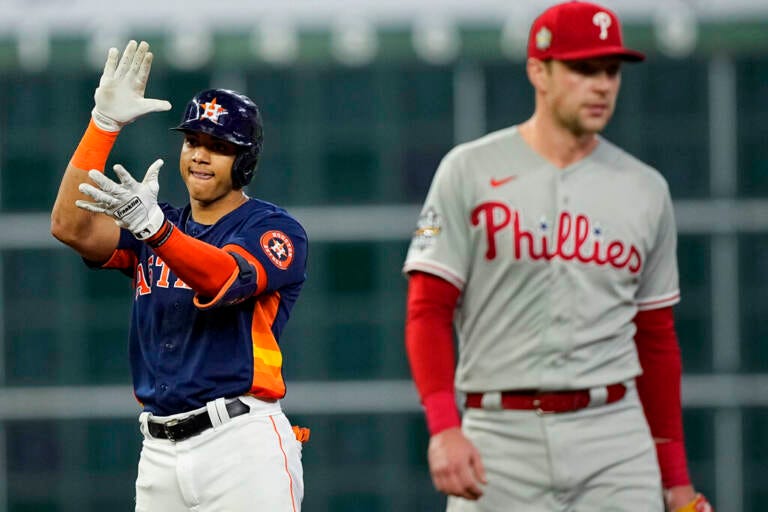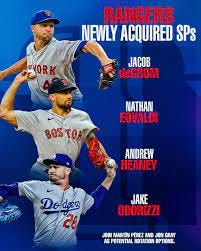This Offseason MLB Teams Tried to Follow the Phillies Model
That teams are copying the World Series loser shows how hard it is to model yourself after the World Series winner.
The free agent market this off-season turned out to be a hot one. It began with Edwin Diaz signing the largest contract in history for a relief pitcher in a his 5-year deal. It continued with star shortstops Trea Turner and Xander Bogaerts signing contracts that will pay them until the age of 41. Aaron Judge was of course the biggest star of the free agent market, and he got a 9 year deal. We even saw signs of the hot market for more mid-level players—Jameson Taillon got a 4-year deal from the Cubs and Zach Eflin got a 3-year deal from the Rays.
Each of these contracts was for more money and—more importantly, I think—for more years than most had projected for these players. You can see early projections of free agent contracts from Fangraphs and from MLB Trade Rumors at the links on each name.
We saw the same phenomenon of paying more than projected here in Houston. Jose Abreu was projected to get a 2 year contract, but the Astros gave him a third year, which was necessary to beat 3-year offers for Abreu from the Guardians and Padres.
Of course, the biggest surprise on the free agent market was Jacob de Grom, who signed in the AL West with the Rangers. Predictions for de Grom were that he would get a 3-year contract. After all, de Grom is entering his age 35 season and has had significant injuries the last two seasons. Instead, he got a 5-year contract.
So why is the free agent market so hot? There are a couple of key reasons identified by baseball writers: the stability provided by the collective bargaining agreement that was agreed to last March encourages spending; the business of baseball is good, and the league reported nearly $11 billion in revenues in 2022.
But there is another reason—one that my be more important to explaining the increase in spending on free agents this offseason. Teams are following the team building model not of the Astros, but of our World Series opponent in 2022—the Philadelphia Phillies.
The Phillies got to the World Series in 2022 by spending a ton of money on free agents, enough for them to grab the final Wild Card playoff spot. Then they got hot in the playoffs, going on a 11-3 run that got them to a 2-1 lead in the World Series. And if not for Cristian Javier doing a Don Larsen impersonation in Game 4 or the gloves of Trey Mancini and Chas McCormick in Game 5…I don’t even want to think about it.
I’ll trace the Phillies model, how other teams are copying it, and why the Phillies model makes the Astros accomplishments since 2015 even more impressive.

The Phillies Model
In some ways, the Phillies were the most impressive team the Astros faced in the playoffs this season. Unlike the Mariners and Yankees, the Phillies actually won a game. But in another way, they were the least impressive team the Astros faced—they won only 87 games in the regular season. They had the 9th worst ERA in the National League, and scored only 62 more runs than they scored.
Those numbers weren’t good, but were good enough to hold off the Brewers for the final wild card spot. And once in the playoffs, they got hot and they got lucky. An improbable late comeback in Game 1 of the Wild Card Series against the Cardinals propelled them to a 9-2 run to win the National League pennant.
But what is important to understanding why the Phillies provide a model to other teams is not just that they barely got in the payoffs and then took advantage of the crapshoot nature of the playoffs to make a deep run. It’s how they built their team—through high priced free agent signings.
The Phillies best players in 2022 were either players they had signed away from other teams (Bryce Harper, Zack Wheeler, Kyle Schwarber) or their own players who they had signed to big contracts to cover their free agents years (JT Realmuto; Aaron Nola).
This wasn’t the plan for the Phillies. They had conducted an Astros-style rebuild, not exceeding 73 wins over a five year span from 2013 to 2017. But the rise never came, and General Manager Matt Klentak got the boot after the 2020 season.
The Phillies have a number of home-grown players in key roles (Rhys Hoskins; Bryson Stott; Ranger Suarez), but each of them tends to be a supporting player, not the superstars that teams like the Astros and Cubs produced through their rebuild.
The Phillies pivoted to the big dollar free agents, pushing their payroll up to fourth in the majors in 2022 after signing Schwarber and Nick Castellanos to big free agent contracts before the season. It paid off…barely.
An Unexpected Turn
But it wasn’t supposed to work like this.
The Major League Baseball Players Association has long opposed playoff expansion under the theory that if the threshold to get into the playoffs was lowered, owners would have less incentive to sign an extra free agent to push themselves to win a few more games.
The outsized role that luck plays in five and seven games series is a key component of this theory. Postseason series are determined more by luck than talent, which gives teams that win 106 games like the Astros less of a guarantee that they can win a series against a more flawed team like the Phillies. Or to put it another way, the 2022 National League featured three 100-win teams; none made it out of the Division Series.
The Rangers Are the Phillies Of the AL
The Texas Rangers apparently noted the Phillies plan and have started following it. The Rangers began a full rebuild in 2017 when the traded Yu Darvish and his pitch-tipping ways to the Dodgers. They have focused a great deal on their farm system and developing prospects, and it has got them very little. Their young players entering 2023 are a couple of utility infielders (Josh Smith, Ezekiel Duran) and a Myles Straw clone in center field (Leody Taveras). They do have a promising young third baseman in Josh Jung, but his 2022 debut was delayed 5 months last season by an offseason weight lifting injury.
Much like the Phillies, the Rangers rebuild is stillborn. So they have shifted into trying to spend their way into a playoff spot. Last offseason they spent a collective $556 million for 21 combined years of Corey Seager, Marcus Semien, and Jon Gray. This offseason, they doubled-down on the strategy, signing starting pitchers Nathan Eovaldi, Andrew Heaney, and Martin Perez in addition to the aforementioned de Grom. It will be a whole rotation of free agent imports.1

The Rangers also seem to be following the Phillies in their ambition. It is unlikely that the Rangers will contend for the division title this season—the team at the south end of I-45 that you root for is the obvious favorite. But the Rangers seem to be aiming for the final Wild Card spot, and then hope they get hot.
They have some chance of achieving this goal. The Depth Charts projections at Fangraphs currently has the Rangers at 41.7 Wins Above Replacement in 2023. That’s 8th among American League teams, but only 1.8 behind the Mariners for 6th place. The Twins are in between at 42.2 fWAR.
The small difference between these three teams means they each enter the season with good chances of winning the final Wild Card spot. And they small difference may give each of these three teams incentives to add more players before Opening Day. It could be the difference between a playoff berth and sitting home in October.
It’s Hard to Match the Astros
The choice of the Phillies and the Rangers to alter their rebuild and focus on signing expensive free agents in an attempt to win 90 games and grab the last Wild Card spot helps to demonstrate how hard it is to pull off a successful rebuild—like the one the Astros did.
Quick quiz: what is the largest contract that the Astros have given to a free agent from another team since Jim Crane took over as owner? It’s the contract Jose Abreu signed this offseason. For $58.5 million. It beat the record held by Josh Reddick, who signed a 4 year, $56 million contract after the 2016 season.
The Astros have given larger contract extensions to their own players—Jose Altuve, Alex Bregman, Yordan Alvarez, and Lance McCullers have all signed larger contracts. But they have never felt pressure to outbid the market for one of the premier free agents.2
And why should they? The Astros built themselves up from three-straight 100 loss seasons to World Series Champion in 2017 by developing a bevy of star level players—Altuve, George Springer, Dallas Keuchel, Correa, McCullers, and Bregman. They did add some free agents, but players like Reddick and Carlos Beltran were complimentary players to the homegrown stars on offense in 2017.
The Astros have kept themselves at the top of the heap in the American League since 2017 despite losing players like Springer, Keuchel, and Correa to free agency by developing another core of star players.
The 2022 World Series champions featured star level performances from homegrown players like Framber Valdez, Cristian Javier, Yordan Alvarez, Kyle Tucker, and Jeremy Pena. The team may have lost a bevy of star level talent to free agency, but they replaced them with another set of stars.
The example of the Phillies and the Rangers show how hard it is to build a 100-win team once. These two teams could not do it and adjusted their course to accept fewer wins but a chance in October. The Astros rebuild blew these two out of the water to win it all in 2017.
Then, the Astros did it again. And it was harder the second time because the Astros had fewer top draft picks with which to stock their farm system. Even a team like the Cubs—who built their own juggernaut from developing their own stars—eventually had to trade away many of those stars because they could no longer compete for October. The Cubs now have one foot in the Astros school—trying to develop a set of prospects while also adding veteran free agents such as Taillon and Marcus Stroman.
So when you see Jacob de Grom on the mound for the Rangers in 2023 or Trea Turner at shortstop for the Phillies, just remember that could be us as Astros fans. But it isn’t, because our player development machine means the Astros don’t have to give out big contracts to win big.
Perez is technically a homegrown player, as he debuted with the Rangers…in 2012. The contract he signed this offseason is fourth free agent contract he has signed.
Thus, the franchise record for signing away a free agent from another team is still held by Carlos Lee, who signed a 6 year/$100M contract after the 2006 season.




While wondering what team Correa's on this week, great analysis, Brian! Before you mentioned it in a caption, I began thinking (as I was reading) that the reason free agency/trades, etc was a likely scenario for most teams trying to replicate the Astros' success and track record, was simply because they lacked the long-term draft success and player development of the 'Stros! And, you nailed it!
Plus, these non-Astros teams, while they realize how we did it, don't or can't do what we do (and, quite obviously, not as well)! And, lacking patience, want success NOW, hence their quick player acquisitions. Now, with all that, I'm guessing they're all trying to start the slow, years-long process of improving their drafting process, as well as upgrading their scouting/PD staffing!